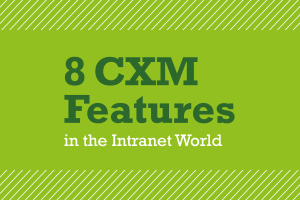8 CXM Features in the Intranet World
Personalization and Segmentation – Poor user adoption is cited as the most common reason for the failure of an intranet project. Why not increase user experience by tailoring content to user needs; communicating in a more personal way? While the obvious place to start is with site search, this is just the tip of the iceberg. Why not personalize content according to department or office location, job role or type, specific personal or professional interests, or even how active they are on social media sites? Making your employees’ experience of your intranet more personal boosts engagement and can strengthen company culture.
A/B and MVT Testing – The main purpose of any website is to sell, whether it be products, services or information. Intranets are no different in this regard, so continued tweaking of a page with a goal to increase conversion rates (e.g. of reading or sharing information), you are therefore selling the information to a higher percentage of your employees. After all, what is known to be the most common cause of frustration for your customers? Uninformed employees!
Web Analytics – Among other things, this basic feature monitors the performance of your intranet. Though it may reveal that your top page is the one containing the lunch menu, this doesn’t have to be bad news, as now you know the best place to display key company communication for maximum visibility. With a “Company News” box next to the menu, suddenly your least active users are exposed to your most important messages.
Lead Scoring – By scoring employee activities such as adding comments to blogs, viewing particular pages, answering FAQs, or writing new blog posts, you can leverage gamification to engage your employees and encourage them to use and contribute to your intranet. And a public reward such as rank/reward charts or badges can increase adoption further.
Email Marketing – While email content personalization, mobile device friendliness and even A/B testing of your internal email messages will undoubtedly come in handy here; the key advantage of email marketing on your intranet is in the ability to track email opening and click-through rates. This gives you insight into the topics your employees really care about. It also affords the opportunity of resending crucial messages to those who didn’t read them the first time.
Mobile Devices – As mobile continues on its path to overtake desktop traffic for public websites, companies should consider adding mobile support to their intranets too for employee convenience and deeper engagement, though security implications may be a huge constraint for internal sites.
Campaign Management – Campaign management will get its play too, especially in situations where your intranet represents a quasi-extranet. So if your company is made up of affiliates or members, campaigns can be a great way to produce segmented results of the success of each campaign.
Marketing Automation – Training and certification are excellent examples of how to leverage marketing automation for intranets. By automating training schedules for employees and adding tests to be triggered after particular parts of the training have been completed, you can maintain a clear view of the training progress of all your employees. This might be used for new employees, but also when educating current employees about industry trends, new company policies, etc. Triggers, waiting steps, conditional steps, and multiple choices can all be used in your marketing automation workflow, making the process smooth, and eliminating the need for manual management. Another scenario in which marketing automation can be used to excellent effect is for employee satisfaction surveys and their FUP based on given responses.
The path to optimized business performance doesn’t necessary start with improving your external customers’ experience, but could start with improving the experience of your internal customers — your employees. Your
intranet deserves the same attention as your public website.
Do you use any of the mentioned features on your Intranet? What other CXM features might be used for Intranets that are missing from this list?
Tell us in comments below!
